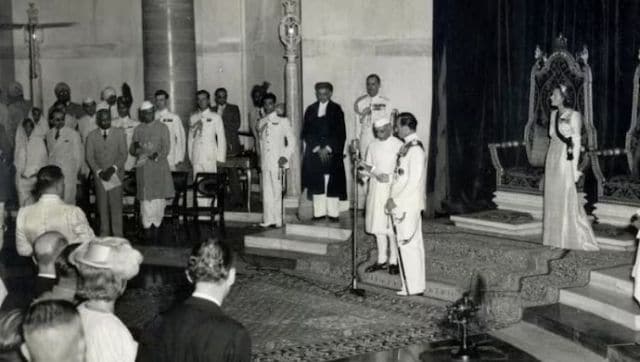It is a historic day for Narendra Modi. He will be sworn in for a third term at Rashtapati Bhavan today.
The oath-taking ceremony will have over 8,000 guests in attendance, including
world leaders
such as Bangladesh prime minister Sheikh Hasina, Sri Lanka president Ranil Wickremesinghe, and the Maldives president
Mohamed Muizzu
. In addition to these leaders and other dignitaries, there will also be
special invitees
such as the rat-hole miners who helped in rescuing the 41 trapped construction workers after a portion of the Silkyara tunnel in Uttarakhand’s Uttarkashi collapsed last year as well as labourers involved in the Central Vista Project.
But have you ever wondered where this tradition of taking the oath of office began? How it has changed in India over the years? We have you covered.
Where did oath-taking come from?
The oath-taking ceremony has been a ritual even before India gained independence. In fact, each country has their own ritual and practices for a swearing-in ceremony. But the one thing that ties them altogether is that the leader takes an oath — to express his/her intention in the future to commit to act in a certain way.
This ritual of taking oaths, however, goes back centuries in Western Europe. As per a report in The Conversation, the most solemn military oath — directly invoking the Roman gods — was the “sacramentum.” By this oath, soldiers swore allegiance to their specific general or commanding consul and, later, to the emperor. Disobedience could earn severe punishments.
As the years rolled on, oath-taking extended across society: kings took coronation oaths, swearing to rule justly and safeguard the people of the kingdom; lesser nobles took oaths of fealty to greater nobles, often for protection and material advantage. Religious leaders such as bishops and abbots also became part of this oath-based system.
And today, each country has its own swearing-in practices. For instance, in the United States, the president-elect takes the oath of office to the chief justice of the Supreme Court. And in India, the prime minister-elect takes the oath to the president of the nation.
How swearing-in ceremonies have evolved in India?
In colonial India, the British authorities used to profess their fidelity to their king and post-Independence, the ministers-elect took the oath of office and professed their allegiance to the Constitution.
On 15 August 1947, when India was declared free, Jawaharlal Nehru stood tall inside Durbar Hall in Rashtrapati Bhavan and took the oath of office as head of the first independent Indian government. Nehru took the oath, swearing by the Indian Constitution, premised then on the Government of India Act 1935.
It was after this that the resplendent Durbar Hall, with its 42-ft-high marble-cased walls, became the location of all oath-taking ceremonies. It was here that Rajendra Prasad was sworn in as India’s first president.
Years later, in 1990, there was a change when it came to swearing-in ceremonies. President R Venkataraman administered the oath to Prime Minister Chandra Shekhar in Rashtrapati Bhavan’s forecourt rather than the Durbar Hall. As per an Indian Express report, the choice to hold it out in the open reflected the PM’s nod to mass politics. Moreover, one could accommodate more people in the open venue.
And in 1999, Prime Minister-elect Atal Bihari Vajpayee also took the oath of office in the open. In 2014 and 2019, Narendra Modi also followed in the footsteps of Vajpayee and held his swearing-in ceremonies in the forecourt, owing to the large number of invitees. In fact, while he had a whopping 4,000 guests for his first swearing-in ceremony, that number increased to 6,000 in 2019.
And while on 9 June, the country will turn on their television sets to watch Narendra Modi and his ministers take the oath of office, it was only in 1984 that this event was telecast live on Doordarshan. It was then that people could watch the historic moment unfold in real time. One official has expected that for 9 June about 100 cameras will be used to broadcast the event live.
How exactly is the oath taken?
The ministers are given a choice to take the oath in the name of god or affirmation in Hindi or English before the President administers it.
And as per the Third Schedule of the Constitution, they take the oath which reads: “I, A. B., do swear in the name of God/solemnly affirm that I will bear true faith and allegiance to the Constitution of India as by law established, [that I will uphold the sovereignty and integrity of India,] that I will faithfully and conscientiously discharge my duties as a Minister for the Union and that I will do right to all manner of people in accordance with the Constitution and the law, without fear or favour, affection or ill-will.
After they take the oath, they then sign the register placed on a table on the side, and the Secretary to the President counter-signs it too.
After the ceremony, the President then hosts a dinner for the guests where a variety of delicacies are served, including the famous Raisina Dal, which takes 48 hours of slow simmering for the perfect taste.
With inputs from agencies
Link to article –
From Roman Empire to Rashtrapati Bhavan, the long history behind oath-taking ceremonies
